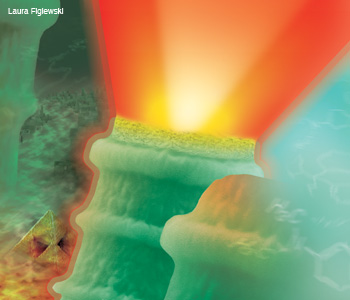Feature
RAPID Lithography: New Photoresists Achieve Nanoscale Resolution
Over the past decade, researchers have shattered the traditional view of the diffraction limit. Using new techniques, they have obtained resolution far smaller than the wavelength of light excitation or emission. Similar concepts are now being applied to photolithography, making it possible to create nanoscale features in a photoresist using visible or near-infrared light.
 Artist's interpretation of the RAPID lithography process.
Artist's interpretation of the RAPID lithography process.
It is well known that diffraction limits the resolution of far-field optical systems: In textbooks, this limitation is often described in terms of the Rayleigh criterion, which states that the resolution of a far-field optical system is given by 0.61λ/NA, where l is the wavelength of light and NA is the numerical aperture of the system. Within this type of description, the practical limit to the resolution of a far-field system is on the order of one-third of the wavelength of the light used.
…Log in or become a member to view the full text of this article.
This article may be available for purchase via the search at Optica Publishing Group.
Optica Members get the full text of Optics & Photonics News, plus a variety of other member benefits.
